
Who are the "subcontractors"?
Subsidiaries are people who work in other departments of the company who specialize in a specific area. Subcontractors are defined as those with whom product managers regularly interact, so knowing who they are is a must.
First, let's look at the principle of division into departments using the example of an IT company:
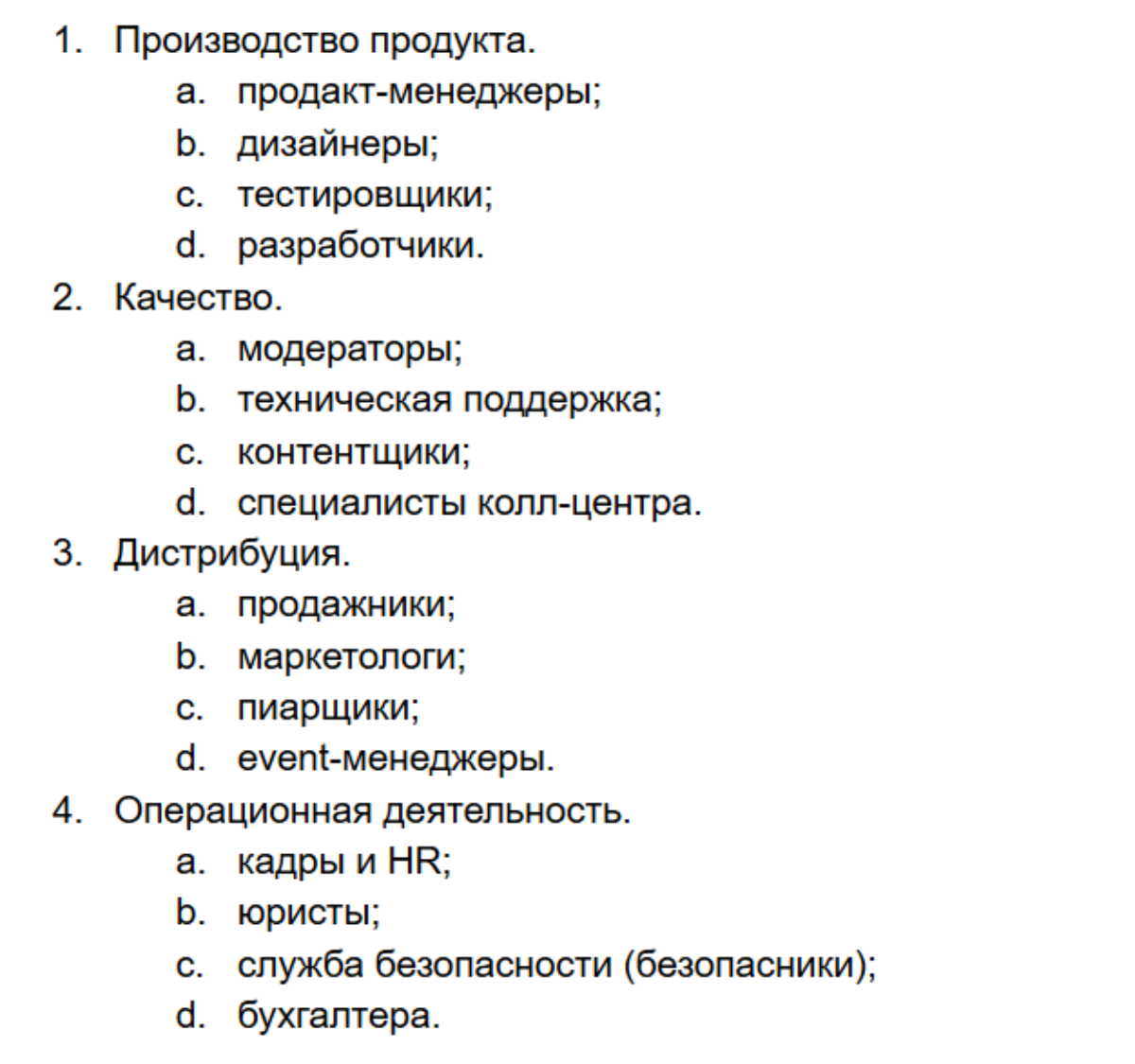

That is, there is a clear structure - separate blocks that include specialists of different ranks. And here's another example in distribution:
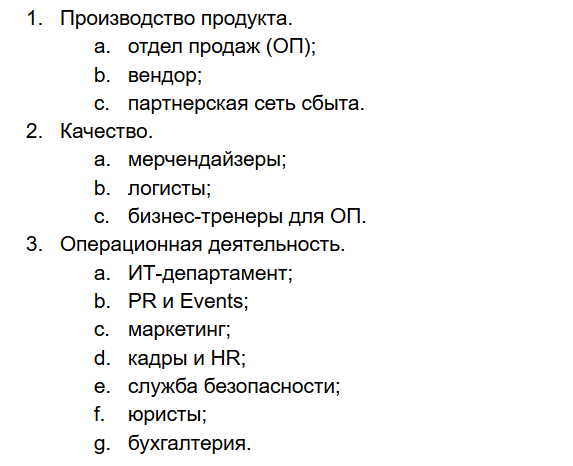

As you can see, the two companies working in different directions have a completely different structure of departments and, as a result, subcontractors. This suggests that there is no universal system of division within the organization, everything depends on the specifics and scope of activity.
The breakdown into departments according to the areas of responsibility and influence within the company is done to simplify the orientation between departments. Knowing the clear structure of subcontractors, you will quickly understand where and to whom you can contact at the moment on the issue or problem that has arisen.
Why do we need "subcontractors" and why is it impossible without them?
Having looked at the examples of breaking down the company into departments and departments, the question arises: why do we need subcontractors, why so many people work in the organization, and why it is impossible without them? They are needed so that the product manager does not perform other people's duties.
The work of the product, as you know, is connected with the signing of contracts, acts and other documentation. In companies where the organization of departments is disrupted, product managers often talk about getting a higher education in law along the way, as they have to understand laws, regulations and other things to work with documents correctly.
It's great when a product takes responsibility and does a lot of product-related work. But when he begins to perform the duties of other specialists, this is bad. Firstly, there is no guarantee that he will fulfill these duties correctly due to his low qualifications in one area or another. Secondly, the product will begin to sacrifice core tasks, as a result of which the integrity of the workflow is destroyed.
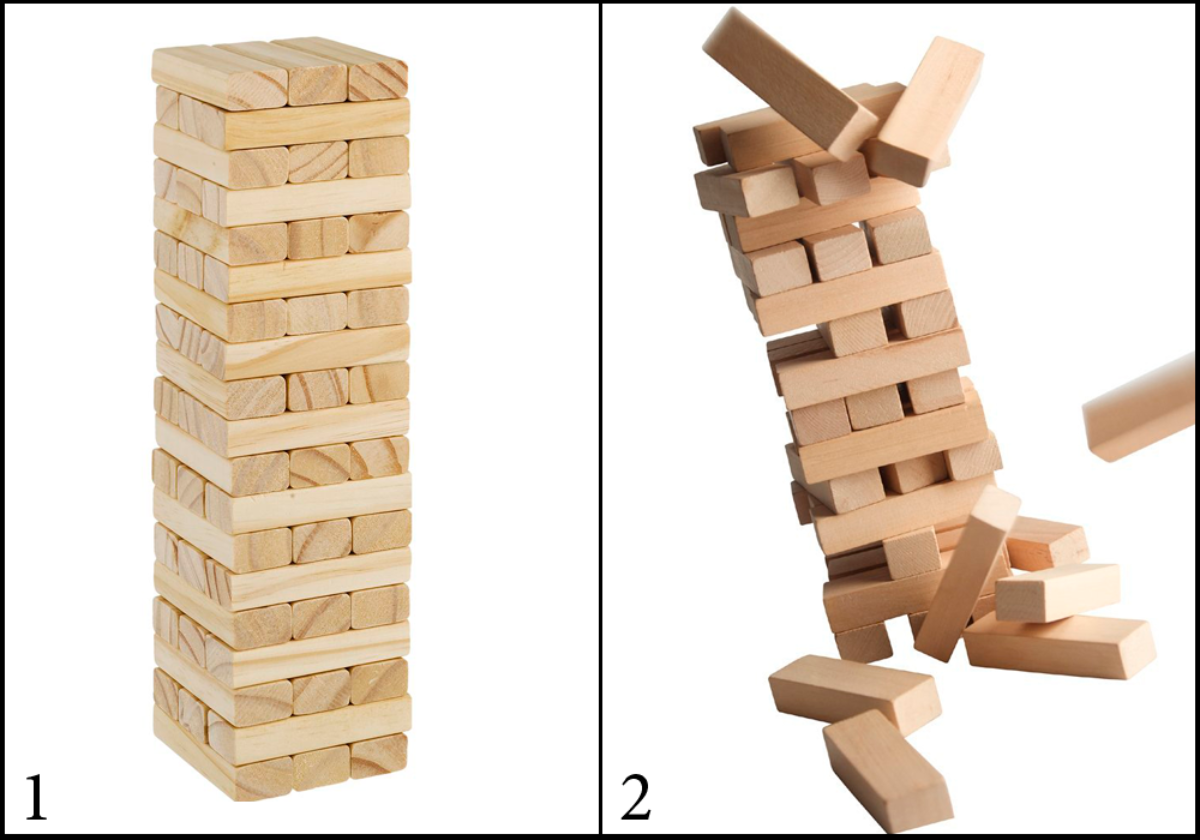
The break of stable work is clearly illustrated by the game "Jenga". The left figure (1) shows a situation when a product performs its direct duties, and transfers other tasks to subcontractors from different departments in accordance with qualifications. The right figure (2) demonstrates the lack of division into departments and departments when the product manager has to perform tasks not related to his qualifications.
Thus, subcontractors in the company are needed for the competent distribution of work processes in accordance with qualifications. The number of departments can be any, the main thing is that the structure is stable.
How to work with other departments that have their own KPIs?
Getting the company structure right and breaking down the departments is only half the battle. It is equally important to understand how to work properly with other departments, especially if they have different KPIs. Inability to interact with subcontractors will lead to low efficiency.
Start by building a circuit. Put "yourself" in the central part, and around - different departments and departments with descriptions on what questions you can contact them.
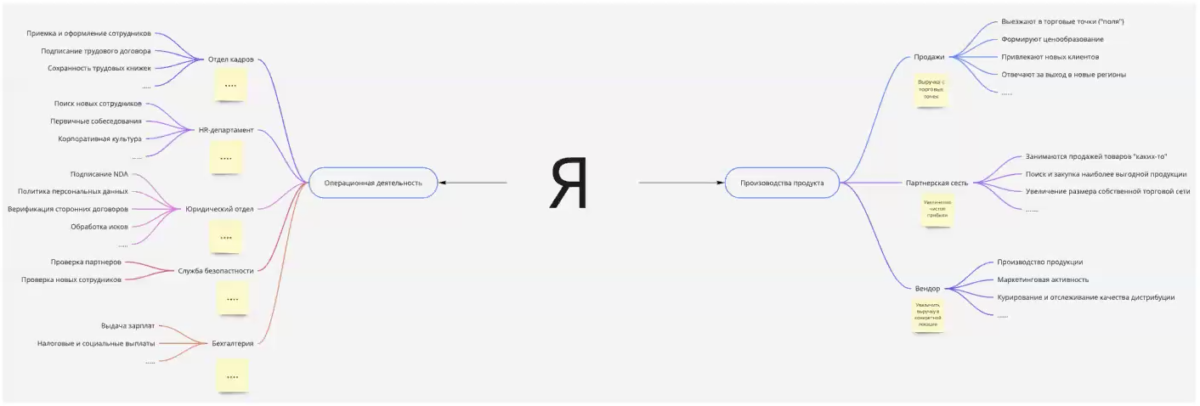
Please note: under each department there is a sticker with a description of the KPI - an indicator by which specialists determine the effectiveness of work.
It is convenient to work with such a card, since you can remove or add a new department / department at any time.
Let's look at a small example based on our map. Let's say a company has decided to launch an online store. First, we find out which department to assign it to, then we determine the KPI and describe the issues (responsibilities) of the new department. This is done in a few minutes; for convenient construction of a mind map, use special services (for example, Miro).
The golden rule of interaction with subcontractors is to simultaneously take into account the key metrics of each. Set goals that take into account the interests of all colleagues, then peace and idyll reign in the organization, and the efficiency of work goes off scale.
By the way, for this purpose it is allowed to divide specialists not according to the type of activity, but according to the metrics they are guided by in their work.

Let's look at a specific example to make the process of proper interaction with subcontractors clearer. Let's say that you are in charge of a product card in an online store.
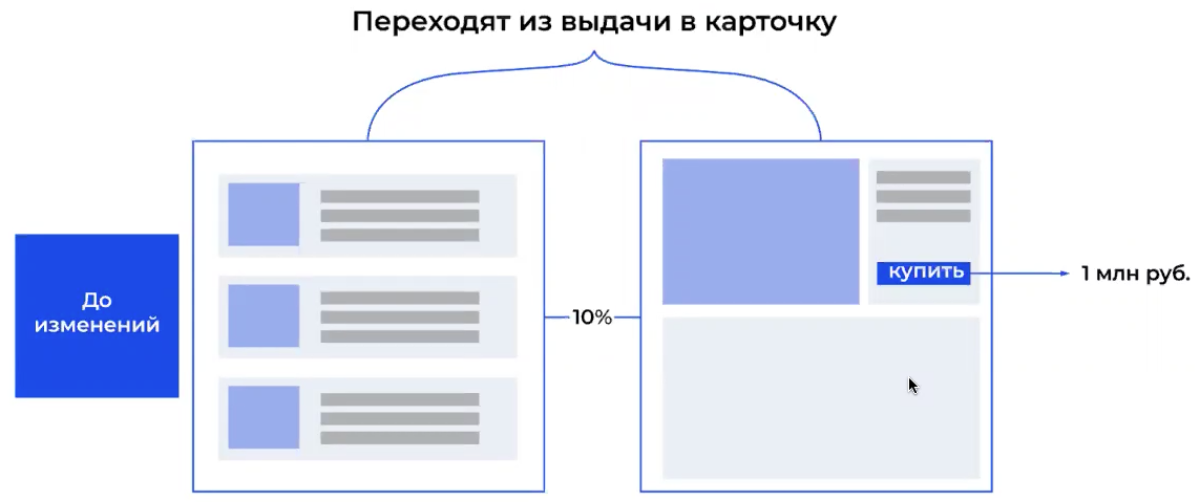
It includes a description of the product, technical characteristics, photographs and a block with a Buy button. You know that at the expense of the button, you get 1 million rubles a month. Accordingly, keep track of all related metrics that affect the bottom line. The closest important metric in this example is the number of clicks from the product catalog to the card (in our case, 10% of the total number of visitors to the online store).
The sales department appears and proposes to make changes: add a pop-up banner to the catalog leading to a page with information on cooperation with legal entities.

Salespeople make a forecast: adding a pop-up (pop-up window) will increase the number of leads from 50 to 100 (2 times). Initially, it will seem that double growth is an excellent point for the development of an online store. But first, think about the implications: what can happen to metrics that are important to other departments? In our case, the number of transitions from the catalog to the cards of specific goods.

It is quite expected that adding a pop-up window will reduce the number of transitions from the catalog to cards (in this example, 2 times - up to 5%). Accordingly, from the "Buy" button you will receive monthly not 1 million rubles, but only 500 thousand rubles.
And then what to do? Add a popup or leave it as it is? Make a decision after doing a little analysis, specific numbers will help you with the right choice. In our case, there is a loss of 500 thousand rubles, so we need to estimate the profit from innovations and compare with the current indicators.
Increasing leads to 100 leads per month will give an additional 300,000 rubles per month. Thus, you will receive 800,000 rubles a month. This is less than the current profit, therefore, the innovation should be abandoned. It remains to correctly convey the decision to the salespeople, arguing it with the calculations. Then no one will be offended, a good atmosphere in the team will remain and productive work will continue.
Formation of negative experiences
The formation of negativity is one of the main problems of many organizations. It accumulates in the course of work, when the tasks of different departments do not coincide with each other due to different metrics. As a result of this, discord in work begins, an opinion appears about the incompetence of certain employees, that no one understands anything, etc. All this is the formation of negative experience that reduces the productivity of the work of departments as a whole and of each specialist individually.
The most common example is related to marketing. The guys from the advertising department have a cool idea to increase profits several times. They present it to the management and get approval with support.
The idea "descends" to the developers from high-priority executives with tight deadlines. They have to deal with technical implementation in conditions of an emergency and with minimal planning, in addition, all the other daily tasks are moving, which no one removed from the plan.
In most cases, hastily implemented ideas "do not shoot", that is, the company does not receive the promised increase in profits several times. As a result, developers develop negative experiences with marketers that disrupt communications between them.

Developing new ideas doesn't have to be quick and spontaneous. Earlier in the articles it was said more than once: what seems very cool to you does not always "come" to the user. Therefore, carry out the work in 4 stages:
- . , .
- . .
- . (MVP, ) «» . .
- . , — .

Accordingly, if the idea has not passed the second or third stage - abandon it and do not take the developers' time. By the way, it is better to carry out the second and third stages several times in order to get the most "smooth" concept, which will later go into full-fledged work.
Carrying out work according to this scheme, it will be possible to avoid the formation of negative experience. There will be no disagreements and bad atmosphere, all team members will treat each other with respect and understanding, and this is the key to productive work.
Framework and visualization of the interaction process
In the last block, we discussed negative experiences that often arise when interacting with subcontractors. Working according to the optimal scheme, which is tied to interviews with users and prototyping, is not always possible due to the opacity of the process.
For example, marketers will not understand the need for this, their deadlines are "burning", they need to quickly implement new functionality. As a result, new disagreements arise. To avoid this, ideas should be transparent for all specialists of the company and visualization of the interaction process will help in this.
Kanban board
Let's try together with you to visualize the workflow within the company or, as it is fashionable to say now, to build a framework of interactions. Let's start by creating a kanban board. You can shape it in any convenient way, but we recommend using Miro - this service already has ready-made templates that simplify and speed up rendering.

A kanban board will help to record all incoming information in one place: ideas, messages from e-mail, instant messengers and other communication channels from subcontractors, current tasks, etc. The possibilities of the tool in this regard are endless, twist it how you want.
Fixing information in one place will help you better concentrate and not keep dozens of thoughts in your head like "so, Gosha from marketing said to check this and that, you need to write it down somewhere." By the way, often different departments think about the same thing, offering the same ideas. By viewing everything in one place, you can easily integrate them and streamline your workflow.
It is desirable that all subcontractors have access to the board. This will save you from the constant calls with the questions "how are things with our idea?" It is enough to go to the board and see the task status. Miro, for example, has the ability to leave comments, which simplifies communication and eliminates short calls that take up office hours.
Assign any task to a specific employee: developer, marketer, salesperson, etc. It also makes communication easier, as other colleagues will know who to contact if they have questions. All this is simple and quick to implement in Miro.
This is one of the options for visualizing the workflow. Over the years, it has proven its worth more than once, increasing the productivity of hundreds of teams. But is this the only option? And if you need to describe the task in more detail? Let's take a look at an alternative option - Project Canvas.
Project Canvas
We have already talked about Canvas models - these are block tables that help in the detailed description of business models. And if with the help of a tool it is possible to decompose an organization into its components, then why not try to do the same with an idea or a task?

See a sample spreadsheet, compiled in real conditions. Each block contains several stickers with basic information that helps in the implementation of the idea. Again, everything is collected in one place at a glance and is very easy to read.
Also note that some of the stickers in the same block are different in color. This is not an accident, but a special gradation: a certain color was assigned to each department of the company to simplify the orientation of the product and developers. That is, the table is shared across all departments (project participants) and the relevant specialists enter the necessary data into the blocks.
This is another example of successful interaction visualization. Earlier it was said that the main idea of changes should be transparent to all departments for productive work. Project Canvas is a great tool for setting a common goal that will be clear to all skill levels.
What happens if you don't?
Avoiding visualization, which helps to define a common goal for all subcontractors, will lead to a bad atmosphere within the team and the formation of negative experiences. It is impossible to achieve the set goals and perform tasks in such an environment. Therefore, visualize the processes, make them "transparent" for the team.
A good example of accumulation of negative experience and inaction is the “endless stick” startup. It was launched in 2014, the product was a simple flash drive that opens access to cloud data storage on the Internet.
Initially, the company developed successfully, technical implementation was in full swing, and there were even rumors of interest from Microsoft. After a while, the project was curtailed, and one of the reasons for the closure was called constant conflicts in the team. As you can see, even a seemingly super cool idea can be doomed due to disagreements and lack of visualization of workflows.
The article is coming to an end, so it's time to summarize everything that has been said. First, subcontractors are colleagues working in other departments and divisions of the company. Second, the product manager regularly interacts with them to solve a variety of problems. Thirdly, it is important to be able to communicate goals to departments with different KPIs, to determine a common metric to achieve high work productivity.
In the latter, visualization of interactions or workflow framework helps a lot. The article describes two methods - kanban boards and project canvas, which have proven their worth in practice. And every time you think about the uselessness of visualization, remember the history of the startup "endless stick".